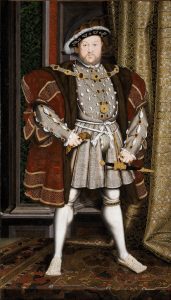Henry VIII
 While today he is most commonly associated with his dubious treatment of his six wives, the legacy of Henry VIII extends far beyond his morally questionable methods of handling marital disputes. Instead, the most important impression of his reign came from the action he had to take to rid himself of one of his aforementioned spouses.
While today he is most commonly associated with his dubious treatment of his six wives, the legacy of Henry VIII extends far beyond his morally questionable methods of handling marital disputes. Instead, the most important impression of his reign came from the action he had to take to rid himself of one of his aforementioned spouses.
It was in 1527 that Henry, frustrated with years of marriage to a woman, Catherine of Aragon, who could not seem to bear him a son, approached Pope Clement VII to seek an annulment of his marriage so that he might attempt to search for a more fruitful partner. He came armed with the argument that, since he had married his brother’s wife contrary to Biblical practice, the marriage was void. Yet the Pope would have none of this case and rejected the maneuver.
After several failed attempts to remove himself from the marriage in a legitimate way, Henry decided he had to move forward without the help of the Church. Around 1530, Henry removed Catherine from his court and married his mistress, Anne Boleyn. While it may have been difficult to tell at the time, Henry had just ushered in the start of the English Reformation.
In 1533, the Pope, furious over Henry’s unsanctioned divorce from Catherine, excommunicated the English King from the Catholic Church. While Henry had, up to that point, been a loyal friend to the papacy and continued to hold Catholic beliefs until his death, he, perhaps inspired by his new wife’s Protestantism, which she had been led to by the writings of humanists like Erasmus, made England’s split from the Catholic Church official by naming himself Supreme Head of the Church of England and seized all Church assets in the country in 1536. A few years later, Henry excommunicated the Pope from his new church, broke up the remaining monasteries, and destroyed all the remaining shrines to the Catholic saints.
The remainder of Henry’s life never saw him repair ties with the Church, and he would go through a further four wives after Anne Boleyn. Still, none of the six women he wed were ever able to grant him the strong male heir he so craved. His only son, Edward VI, died at the young age of 15, though one of his daughters, Elizabeth I, would go on to become one of the most famous monarchs in British history.
Henry’s reign bore witness to the pivotal moment in which perhaps the most powerful nation in Europe official broke with the Catholic Church. His legacy was that of a Renaissance man, a strong ruler, and an intellectually accomplished figure with a keen eye for reform, even if it was done often in a self serving manner. England remained separate from the Catholic Church even after his reign, and though it would get the nation into several vicious struggles over time, the move is considered important in shaping the global religious and social climate, and the Reformation would likely never have been the same without Henry’s work.
Works Cited
Elton, Geoffrey R. “Henry VIII.” Encyclopædia Britannica, Encyclopædia Britannica, Inc., 29 June 2017, www.britannica.com/biography/Henry-VIII-king-of-England.
“Henry VIII.” BBC History, BBC, www.bbc.co.uk/history/people/henry_viii/.
“Henry VIII.” Biography.com, A&E Networks Television, 28 Apr. 2017, www.biography.com/people/henry-viii-9335322.
John Simkin. “Henry VIII.” Spartacus Educational, Spartacus Educational, spartacus-educational.com/TUDhenry8.htm.
Lindberg, Carter. The European Reformations Sourcebook, 2nd Edition. John Wiley & Sons, 2014.
Marshall, Peter. The Reformation: a Very Short Introduction. Oxford University Press, 2009.
“The Reformation.” History Learning Site, The History Learning Site, 16 Aug. 2016, www.historylearningsite.co.uk/tudor-england/the-reformation/.
“Virtual Museum of Protestantism.” Muse Virtuel Du Protestantisme, www.museeprotestant.org/en/notice/protestantism-in-england-in-the-16th-century-separation-from-rome/.